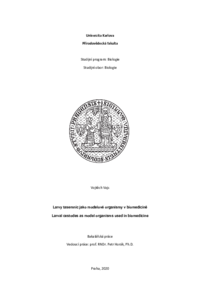Larvy tasemnic jako modelové organismy v biomedicíně
Larval cestodes as model organisms used in biomedicine
bakalářská práce (OBHÁJENO)

Zobrazit/
Trvalý odkaz
http://hdl.handle.net/20.500.11956/119568Identifikátory
SIS: 219295
Kolekce
- Kvalifikační práce [21483]
Autor
Vedoucí práce
Oponent práce
Kolářová, Iva
Fakulta / součást
Přírodovědecká fakulta
Obor
Biologie
Katedra / ústav / klinika
Katedra parazitologie
Datum obhajoby
8. 7. 2020
Nakladatel
Univerzita Karlova, Přírodovědecká fakultaJazyk
Čeština
Známka
Výborně
Klíčová slova (česky)
Taenia, Mesocestoides, vztahy parazit-hostitelKlíčová slova (anglicky)
Taenia, Mesocestoides, host-parasite interactionsTaenia crassiceps a Mesocestoides corti jsou v biomedicíně široce využívanými druhy tasemnic. Jejich vlastnosti z nich činí vhodné modely pro různorodé formy neurocysticerkózy a jejich schopnost ovlivnit organismus hostitele se nabízí jako potenciálně vhodná léčba chorob z řad autoimunitních onemocnění, jako je diabetes 1. typu nebo roztroušená skleróza, a různých druhů rakoviny, jako jsou melanomy nebo rakovina prsu. Imunomodulační schopnosti helmintů, které jsou známy už delší dobu, si v nedávných letech vyžádaly pozornost vědců svým účinkem na zánětlivé reakce organismu hostitele a také kvůli tomu, že některé jejich produkty dokáží posílit imunitní reakci. Současný výzkum si dává za cíl objevit další mechanismy účinku produktů helmintů a rovněž určit onemocnění, na která by se mohly aplikovat. Tato práce se věnuje představení důvodů, pro něž jsou tyto dvě tasemnice tak hojně využívanými modely, účinkům infekce na hostitelský organizmus, využití pro studium neurocysticerkózy a různým příkladům, ve kterých se především T. crassiceps a její produkty ukázaly jako potenciální kandidát pro vývoj nových léčebných postupů či posílení těch stávajících. Klíčová slova: Taenia crassiceps, Mesocestoides corti, neurocysticerkóza, imunomodulace, diabetes 1. typu, roztroušená skleróza, melanomy
Both species of tapeworm, Taenia crassiceps and Mesocestoides corti, are used in biomedical research. Their exceptional attributes make them suitable model organisms for various forms of neurocysticercosis. Moreover, their ability to affect the metabolism and immunity of their hosts represents a potential cure for various autoimmune diseases, such as type 1 diabetes or multiple sclerosis, and various types of cancer, such as melanoma or breast cancer. The immunomodulatory capabilities of helminths and their mechanisms, which have been known for some time already, have recently commanded researchers' attention to their effect on the host organism's inflammatory reactions, including the enhancing impact of their products on the immune response. Current research is seeking to reveal the effects and underlying mechanisms of these helminth abilities and to discover further diseases, in which they could be applied. This review summarizes the reasons these cestodes are used as models, the effects of cestode infection on the host organism, and their use in neurocysticercosis study. Also, various examples where primarily T. crassiceps shows to be a potential candidate for the development of new treatments or the improvement of those already in use will be mentioned. Key words: Taenia crassiceps,...
